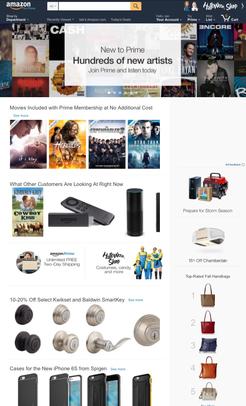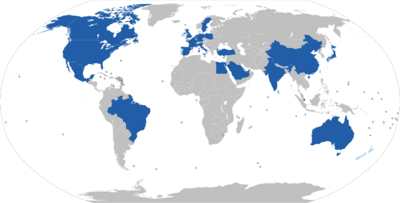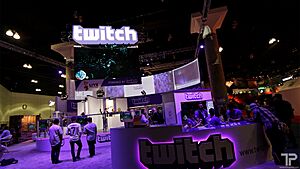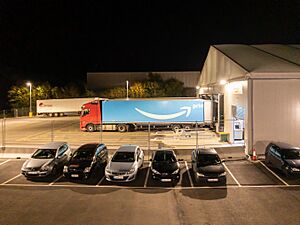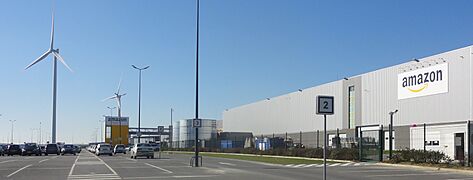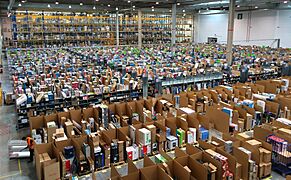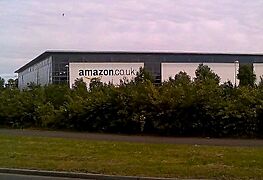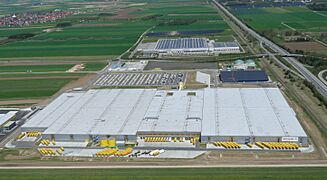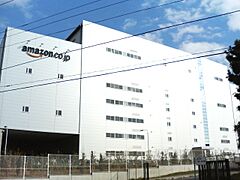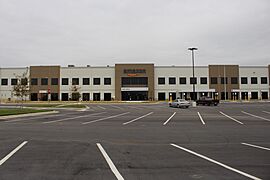Amazon (company) facts for kids

Logo used since January 2000
|
|
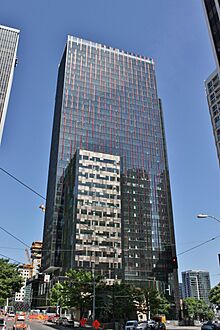
Amazon's headquarters, the Doppler
|
|
|
Trade name
|
Amazon |
|---|---|
|
Formerly
|
Cadabra, Inc. (1994–1995) |
| Public | |
| Traded as |
|
| ISIN | ISIN: [https://isin.toolforge.org/?language=en&isin=US0231351067 US0231351067] |
| Industry |
|
| Founded | July 5, 1994, in Bellevue, Washington, U.S. |
| Founder | Jeff Bezos |
| Headquarters |
,
U.S.
|
|
Area served
|
Worldwide |
|
Key people
|
|
| Products | |
| Services |
|
| Revenue | |
|
Operating income
|
|
| Total assets | |
| Total equity | |
| Owner | Jeff Bezos (9.8%) |
|
Number of employees
|
≈ 1,525,000 (Dec. 2023) |
| Subsidiaries |
List
A9.com
AbeBooks Alexa Internet Amazon.com Amazon Air Amazon Books Amazon Fresh Amazon Games Amazon Lab126 Amazon Logistics Amazon Pharmacy Amazon Publishing Amazon Robotics Amazon MGM Studios AWS Audible Blink Body Labs Book Depository ComiXology Eero LLC Goodreads Graphiq IMDb Kuiper Systems PillPack Ring Souq.com Twitch Interactive Whole Foods Market Woot Zappos Zoox |
Amazon.com, Inc., doing business as Amazon ( am-Ə-zon; am-Ə-zən), is an American multinational technology company, engaged in e-commerce, cloud computing, online advertising, digital streaming, and artificial intelligence. It is considered one of the Big Five American technology companies; the other four are Alphabet (parent company of Google), Apple, Meta (parent company of Facebook), and Microsoft.
Amazon was founded on July 5, 1994, by Jeff Bezos in Bellevue, Washington. The company originally started as an online marketplace for books but gradually expanded its offerings to include a wide range of product categories. This diversification led to it being referred to as "The Everything Store".
The company has multiple subsidiaries, including Amazon Web Services, providing cloud computing, Zoox, a self-driving car division, Kuiper Systems, a satellite Internet provider, and Amazon Lab126, a computer hardware R&D provider. Other subsidiaries include Ring, Twitch, IMDb, and Whole Foods Market. Its acquisition of Whole Foods in August 2017 for US$13.4 billion substantially increased its market share and presence as a physical retailer.
Amazon has a reputation as a disruptor of industries through technological innovation and aggressive reinvestment of profits into capital expenditures. As of 2023[update], it is the world's largest online retailer and marketplace, smart speaker provider, cloud computing service through AWS, live-streaming service through Twitch, and Internet company as measured by revenue and market share. In 2021, it surpassed Walmart as the world's largest retailer outside of China, driven in large part by its paid subscription plan, Amazon Prime, which has close to 200 million subscribers worldwide. It is the second-largest private employer in the United States.
As of October 2023, Amazon is the 12th-most visited website in the world and 82% of its traffic comes from the United States.
Amazon also distributes a variety of downloadable and streaming content through its Amazon Prime Video, MGM+, Amazon Music, Twitch, Audible and Wondery units. It publishes books through its publishing arm, Amazon Publishing, film and television content through Amazon MGM Studios, including the Metro-Goldwyn-Mayer studio which acquired in March 2022. It also produces consumer electronics—most notably, Kindle e-readers, Echo devices, Fire tablets, and Fire TVs.
Amazon has been criticized for customer data collection practices, a toxic work culture, censorship, tax avoidance, and anti-competitive behavior.
History
1994–2009: early years
Amazon was founded on July 5, 1994, by Jeff Bezos, who chose the Seattle area for its abundance of technical talent, as Microsoft was in the area.
Amazon went public in May 1997. It began selling music and videos in 1998, and began international operations by acquiring online sellers of books in the United Kingdom and Germany. In the subsequent year, it initiated the sale of a diverse range of products, including music, video games, consumer electronics, home improvement items, software, games, and toys.
In 2002, it launched Amazon Web Services (AWS), which initially focused on providing APIs for web developers to build web applications on top of Amazon's ecommerce platform. In 2004, AWS was expanded to provide website popularity statistics and web crawler data from the Alexa Web Information Service. AWS later shifted toward providing enterprise services with Simple Storage Service (S3) in 2006, and Elastic Compute Cloud (EC2) in 2008, allowing companies to rent data storage and computing power from Amazon. In 2006, Amazon also launched the Fulfillment by Amazon program, which allowed individuals and small companies (called "third-party sellers") to sell products through Amazon's warehouses and fulfillment infrastructure.
2010–present: growth
Amazon purchased the Whole Foods Market supermarket chain in 2017. It is the leading e-retailer in the United States with approximately US$178 billion net sales in 2017. It has over 300 million active customer accounts globally.
Amazon saw large growth during the COVID-19 pandemic, hiring more than 100,000 staff in the United States and Canada. Some Amazon workers in the US, France, and Italy protested the company's decision to "run normal shifts" due to COVID-19's ease of spread in warehouses. In Spain, the company faced legal complaints over its policies, while a group of US Senators wrote an open letter to Bezos expressing concerns about workplace safety.
On February 2, 2021, Bezos announced that he would step down as CEO to become executive chair of Amazon's board. The transition officially took place on July 5, 2021, with former CEO of AWS Andy Jassy replacing him as CEO. In January 2023, Amazon cut over 18,000 jobs, primarily in consumer retail and its human resources division in an attempt to cut costs.
On November 8, 2023, a plan was adopted for Jeff Bezos to sell approximately 50 million shares of the company over the next year (the deadline for the entire sales plan is January 31, 2025). The first step was the sale of 12 million shares for about $2 billion.
Products and services
Amazon.com

Logo since January 2000
|
|
|
Type of site
|
E-commerce |
|---|---|
| Available in |
|
| Owner | Amazon |
| Website | (original US site) |
| Commercial | Yes |
| Registration | Optional |
| Launched | 1995 |
| Current status | Active |
| Written in | C++ and Java |
Amazon.com is an e-commerce platform that sells many product lines, including media (books, movies, music, and software), apparel, baby products, consumer electronics, beauty products, gourmet food, groceries, health and personal care products, industrial & scientific supplies, kitchen items, jewelry, watches, lawn and garden items, musical instruments, sporting goods, tools, automotive items, toys and games, and farm supplies and consulting services. Amazon websites are country-specific (for example, amazon.com for the US and amazon.co.uk for UK) though some offer international shipping.
Visits to amazon.com grew from 615 million annual visitors in 2008, to more than 2 billion per month in 2022. The e-commerce platform is the 14th most visited website in the world.
Results generated by Amazon's search engine are partly determined by promotional fees. The company's localized storefronts, which differ in selection and prices, are differentiated by top-level domain and country code:
| Country | share |
|---|---|
| United States | 69.3% |
| Germany | 6.5% |
| United Kingdom | 5.8% |
| Japan | 4.8% |
| Other | 13.6% |
| Region | Country | Domain name | Since | Languages | Notes |
|---|---|---|---|---|---|
| Africa | Egypt | amazon.eg | September 2021 | Arabic, English | Formerly known as Souq.com Egypt |
| Americas | Brazil | amazon.com.br | December 2012 | Portuguese | |
| Canada | amazon.ca | June 2002 | English, French | ||
| Mexico | amazon.com.mx | August 2013 | Spanish | ||
| United States | amazon.com | July 1995 | English, Spanish, Arabic, German, Hebrew, Korean, Portuguese, Chinese (Simplified), Chinese (Traditional) | International customers without a localized Amazon website may purchase eBooks from the Kindle Store on Amazon US. | |
| Asia | China | amazon.cn | September 2004 | Chinese (Simplified) | Formerly known as Joyo.com CHN |
| India | amazon.in | June 2013 | English, Hindi, Tamil, Telugu, Kannada, Malayalam, Bengali, Marathi | ||
| Japan | amazon.co.jp | November 2000 | Japanese, English, Chinese (Simplified) | ||
| Saudi Arabia | amazon.sa | June 2020 | Arabic, English | Formerly known as Souq.com KSA | |
| Singapore | amazon.sg | July 2017 | English | ||
| Turkey | amazon.com.tr | September 2018 | Turkish | ||
| United Arab Emirates | amazon.ae | May 2019 | Arabic, English | Formerly known as Souq.com UAE | |
| Europe | Belgium | amazon.com.be | October 2022 | Dutch, French, English | |
| France | amazon.fr | August 2000 | French | ||
| Germany | amazon.de | October 1998 | German, English, Czech, Dutch, Polish, Turkish | Also serves Austria, Denmark and Switzerland | |
| Italy | amazon.it | November 2010 | Italian | ||
| Netherlands | amazon.nl | November 2014 | Dutch, English | Initially only books & e-books, full shop opened March 2020 | |
| Poland | amazon.pl | March 2021 | Polish | ||
| Spain | amazon.es | September 2011 | Spanish, Portuguese | Also serves Portugal | |
| Sweden | amazon.se | October 2020 | Swedish, English | ||
| United Kingdom | amazon.co.uk | October 1998 | English | Also serves Ireland | |
| Oceania | Australia | amazon.com.au | November 2017 | English | Also serves New Zealand |
Merchant partnerships
In 2000, US toy retailer Toys "R" Us entered into a 10-year agreement with Amazon, valued at $50 million per year plus a cut of sales, under which Toys "R" Us would be the exclusive supplier of toys and baby products on the service, and the chain's website would redirect to Amazon's Toys & Games category. In 2004, Toys "R" Us sued Amazon, claiming that because of a perceived lack of variety in Toys "R" Us stock, Amazon had knowingly allowed third-party sellers to offer items on the service in categories that Toys "R" Us had been granted exclusivity. In 2006, a court ruled in favor of Toys "R" Us, giving it the right to unwind its agreement with Amazon and establish its independent e-commerce website. The company was later awarded $51 million in damages.
In 2001, Amazon entered into a similar agreement with Borders Group, under which Amazon would comanage Borders.com as a co-branded service. Borders pulled out of the arrangement in 2007, with plans to also launch its own online store.
On October 18, 2011, Amazon.com announced a partnership with DC Comics for the exclusive digital rights to many popular comics, including Superman, Batman, Green Lantern, The Sandman, and Watchmen. The partnership has caused well-known bookstores like Barnes & Noble to remove these titles from their shelves.
In November 2013, Amazon announced a partnership with the United States Postal Service to begin delivering orders on Sundays. The service, included in Amazon's standard shipping rates, initiated in metropolitan areas of Los Angeles and New York because of the high-volume and inability to deliver in a timely way, with plans to expand into Dallas, Houston, New Orleans and Phoenix by 2014.
In June 2017, Nike agreed to sell products through Amazon in exchange for better policing of counterfeit goods. This proved unsuccessful and Nike withdrew from the partnership in November 2019. Companies including IKEA and Birkenstock also stopped selling through Amazon around the same time, citing similar frustrations over business practices and counterfeit goods.
In September 2017, Amazon ventured with one of its sellers JV Appario Retail owned by Patni Group which has recorded a total income of US$ 104.44 million (₹759 crore) in financial year 2017–2018.
As of October 11, 2017[update], AmazonFresh sold a range of Booths branded products for home delivery in selected areas.
In November 2018, Amazon reached an agreement with Apple Inc. to sell selected products through the service, via the company and selected Apple Authorized Resellers. As a result of this partnership, only Apple Authorized Resellers may sell Apple products on Amazon effective January 4, 2019.
Private-label products
Amazon sells many products under its own brand names, including phone chargers, batteries, and diaper wipes. The AmazonBasics brand was introduced in 2009, and now features hundreds of product lines, including smartphone cases, computer mice, batteries, dumbbells, and dog crates. Amazon owned 34 private-label brands as of 2019. These brands account for 0.15% of Amazon's global sales, whereas the average for other large retailers is 18%. Other Amazon retail brands include Presto!, Mama Bear, and Amazon Essentials.
Third-party sellers
Amazon derives many of its sales (around 40% in 2008) from third-party sellers who sell products on Amazon. Some other large e-commerce sellers use Amazon to sell their products in addition to selling them through their websites. The sales are processed through Amazon.com and end up at individual sellers for processing and order fulfillment and Amazon leases space for these retailers. Small sellers of used and new goods go to Amazon Marketplace to offer goods at a fixed price.
Affiliate program
Publishers can sign up as affiliates and receive a commission for referring customers to Amazon by placing links to Amazon on their websites if the referral results in a sale. Worldwide, Amazon has "over 900,000 members" in its affiliate programs. In the middle of 2014, the Amazon Affiliate Program is used by 1.2% of all websites and it is the second most popular advertising network after Google Ads. It is frequently used by websites and non-profits to provide a way for supporters to earn them a commission.
Associates can access the Amazon catalog directly on their websites by using the Amazon Web Services (AWS) XML service. A new affiliate product, aStore, allows Associates to embed a subset of Amazon products within another website, or linked to another website. In June 2010, Amazon Seller Product Suggestions was launched to provide more transparency to sellers by recommending specific products to third-party sellers to sell on Amazon. Products suggested are based on customers' browsing history.
Product reviews
Amazon allows users to submit reviews to the web page of each product. Reviewers must rate the product on a rating scale from one to five stars. Amazon provides a badging option for reviewers which indicates the real name of the reviewer (based on confirmation of a credit card account) or which indicates that the reviewer is one of the top reviewers by popularity. As of December 16, 2020, Amazon removed the ability of sellers and customers to comment on product reviews and purged their websites of all posted product review comments.
When publishers asked Bezos why Amazon would publish negative reviews, he defended the practice by claiming that Amazon.com was "taking a different approach ... we want to make every book available—the good, the bad and the ugly ... to let truth loose".
Amazon sales rank
The Amazon sales rank (ASR) indicates the popularity of a product sold on any Amazon locale. It is a relative indicator of popularity that is updated hourly. Effectively, it is a "best sellers list" for the millions of products stocked by Amazon. While the ASR has no direct effect on the sales of a product, it is used by Amazon to determine which products to include in its bestsellers lists. Products that appear in these lists enjoy additional exposure on the Amazon website and this may lead to an increase in sales. In particular, products that experience large jumps (up or down) in their sales ranks may be included within Amazon's lists of "movers and shakers"; such a listing provides additional exposure that might lead to an increase in sales. For competitive reasons, Amazon does not release actual sales figures to the public. However, Amazon has now begun to release point of sale data via the Nielsen BookScan service to verified authors. While the ASR has been the source of much speculation by publishers, manufacturers, and marketers, Amazon itself does not release the details of its sales rank calculation algorithm. Some companies have analyzed Amazon sales data to generate sales estimates based on the ASR, though Amazon states:
Please keep in mind that our sales rank figures are simply meant to be a guide of general interest for the customer and not definitive sales information for publishers—we assume you have this information regularly from your distribution sources
—Amazon.com Help
Physical stores
In November 2015, Amazon opened a physical Amazon Books store in University Village in Seattle. The store was 5,500 square feet and prices for all products match those on its website. Amazon opened its tenth physical book store in 2017; media speculation at the time suggested that Amazon planned to eventually roll out 300 to 400 bookstores around the country. All of its locations were closed in 2022 along with other retail locations under the "Amazon 4-Star" brand.
In July 2016, the company announced that it was opening a 1,100,000 ft (335,280.0 m) square foot facility in Palmer Township in the Lehigh Valley region of eastern Pennsylvania. As of 2024, Amazon is Lehigh Valley region's third-largest employer.
In 2020, Amazon Fresh opened several physical stores in the U.S. and the United Kingdom.
Hardware and services
Amazon has a number of products and services available, including its digital assistant Alexa, Amazon Music, and Prime Video for music and videos respectively, the Amazon Appstore for Android apps, the Kindle line of eink e-readers, Fire and Fire HD color LCD tablets. Audible provides audiobooks for purchase and listening.
In September 2021, Amazon announced the launch of Astro, its first household robot, powered by its Alexa smart home technology. This can be remote-controlled when not at home, to check on pets, people, or home security. It will send owners a notification if it detects something unusual.
In January 2023, Amazon announced the launch of RXPass, a prescription drug delivery service. It allows U.S. Amazon Prime members to pay a $5 monthly fee for access to 60 medications. The service was launched immediately after the announcement except in states with specific prescription delivery requirements. Beneficiaries of government healthcare programs such as Medicare and Medicaid will not be able to sign up for RXPass.
Subsidiaries
Amazon owns over 100 subsidiaries, including Amazon Web Services, Audible, Diapers.com, Goodreads, IMDb, Kiva Systems (now Amazon Robotics), One Medical, Shopbop, Teachstreet, Twitch, Zappos, and Zoox.
Amazon Web Services
Amazon Web Services (AWS) is a subsidiary of that provides on-demand cloud computing platforms and APIs to individuals, companies, and governments, on a metered pay-as-you-go basis. These cloud computing web services provide distributed computing processing capacity and software tools via AWS server farms. As of 2021 Q4, AWS has 33% market share for cloud infrastructure while the next two competitors Microsoft Azure and Google Cloud have 21%, and 10% respectively, according to Synergy Group.
Audible
Audible is a seller and producer of spoken audio entertainment, information, and educational programming on the Internet. Audible sells digital audiobooks, radio and television programs, and audio versions of magazines and newspapers. Through its production arm, Audible Studios, Audible has also become the world's largest producer of downloadable audiobooks. On January 31, 2008, Amazon announced it would buy Audible for about $300 million. The deal closed in March 2008 and Audible became a subsidiary of Amazon.
Goodreads
Goodreads is a "social cataloging" website founded in December 2006 and launched in January 2007 by Otis Chandler, a software engineer, and entrepreneur, and Elizabeth Khuri. The website allows individuals to freely search Goodreads' extensive user-populated database of books, annotations, and reviews. Users can sign up and register books to generate library catalogs and reading lists. They can also create their groups of book suggestions and discussions. In December 2007, the site had over 650,000 members, and over a million books had been added. Amazon bought the company in March 2013.
Ring
Ring is a home automation company founded by Jamie Siminoff in 2013. It is primarily known for its WiFi powered smart doorbells, but manufactures other devices such as security cameras. Amazon bought Ring for US$1 billion in 2018.
Twitch
Twitch is a live streaming platform for video, primarily oriented towards video gaming content. Twitch was acquired by Amazon in August 2014 for $970 million. The site's rapid growth had been boosted primarily by the prominence of major esports competitions on the service, leading GameSpot senior esports editor Rod Breslau to have described the service as "the ESPN of esports". As of 2015[update], the service had over 1.5 million broadcasters and 100 million monthly viewers.
Whole Foods Market
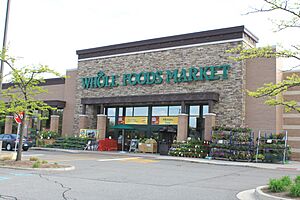
Whole Foods Market is an American supermarket chain exclusively featuring foods without artificial preservatives, colors, flavors, sweeteners, and hydrogenated fats. Amazon acquired Whole Foods for $13.7 billion in August 2017.
Other
Other Amazon subsidiaries include:
- A9.com, a company focused on researching and building innovative technology; it has been a subsidiary since 2003.
- Amazon Academy, formerly JEE Ready, is an online learning platform for engineering students to prepare for competitive exams like the Joint Entrance Examination (JEE), launched by Amazon India on 13 January 2021
- Amazon Maritime, Inc. holds a Federal Maritime Commission license to operate as a non-vessel-owning common carrier (NVOCC), which enables the company to manage its shipments from China into the United States.
- Amazon Pharmacy is an online delivery service dedicated to prescription drugs, launched in November 2020. The service provides discounts up to 80% for generic drugs and up to 40% for branded drugs for Prime subscribe users. The products can be purchased on the company's website or at over 50,000 bricks-and-mortar pharmacies in the United States.
- Annapurna Labs, an Israel-based microelectronics company reputedly for US$350–370M acquired by Amazon Web Services in January 2015 .
- Beijing Century Joyo Courier Services, which applied for a freight forwarding license with the US Maritime Commission. Amazon is also building out its logistics in trucking and air freight to potentially compete with UPS and FedEx.
- Brilliance Audio, an audiobook publisher founded in 1984 by Michael Snodgrass in Grand Haven, Michigan. The company produced its first eight audio titles in 1985. The company was purchased by Amazon in 2007 for an undisclosed amount. At the time of the acquisition, Brilliance was producing 12–15 new titles a month. It operates as an independent company within Amazon. In 1984, Brilliance Audio invented a technique for recording twice as much on the same cassette. The technique involved recording on each of the two channels of each stereo track. It has been credited with revolutionizing the burgeoning audiobook market in the mid-1980s since it made unabridged books affordable.
- ComiXology, a cloud-based digital comics platform with over 200 million comic downloads as of September 2013[update]. It offers a selection of more than 40,000 comic books and graphic novels across Android, iOS, Fire OS and Windows 8 devices and over a web browser. Amazon bought the company in April 2014.
- CreateSpace, which offers self-publishing services for independent content creators, publishers, film studios, and music labels, became a subsidiary in 2009.
- Eero, an electronics company specializing in mesh-networking Wifi devices founded as a startup in 2014 by Nick Weaver, Amos Schallich, and Nate Hardison to simplify and innovate the smart home. Eero was acquired by Amazon in 2019 for US$97 million. Eero has continued to operate under its banner and advertises its commitment to privacy despite early concerns from the company's acquisition.
- Health Navigator is a startup developing APIs for online health services acquired in October 2019. The startup will form part of Amazon Care, which is the company's employee healthcare service. This follows the 2018 purchase of PillPack for under $1 billion, which has also been included into Amazon Care.
- Junglee, a former online shopping service provided by Amazon that enabled customers to search for products from online and offline retailers in India. Junglee started as a virtual database that was used to extract information from the Internet and deliver it to enterprise applications. As it progressed, Junglee started to use its database technology to create a single window marketplace on the Internet by making every item from every supplier available for purchase. Web shoppers could locate, compare and transact millions of products from across the Internet shopping mall through one window. Amazon acquired Junglee in 1998, and the website Junglee.com was launched in India in February 2012 as a comparison-shopping website. It curated and enabled searching for a diverse variety of products such as clothing, electronics, toys, jewelry, and video games, among others, across thousands of online and offline sellers. Millions of products are browsable, the client selects a price, and then they are directed to a seller. In November 2017, Amazon closed down Junglee.com and the former domain currently redirects to Amazon India.
- Kuiper Systems, a subsidiary of Amazon, set up to deploy a broadband satellite internet constellation with an announced 3,236 Low Earth orbit satellites to provide satellite based Internet connectivity.
- Lab126, developers of integrated consumer electronics such as the Kindle, became a subsidiary in 2004.
- Shelfari, a former social cataloging website for books. Shelfari users built virtual bookshelves of the titles which they owned or had read and they could rate, review, tag and discuss their books. Users could also create groups that other members could join, create discussions and talk about books, or other topics. Recommendations could be sent to friends on the site for what books to read. Amazon bought the company in August 2008. Shelfari continued to function as an independent book social network within the Amazon until January 2016, when Amazon announced that it would be merging Shelfari with Goodreads and closing down Shelfari.
- Souq, the former largest e-commerce platform in the Arab world. The company launched in 2005 in Dubai, United Arab Emirates and served multiple areas across the Middle East. On March 28, 2017, Amazon acquired Souq.com for $580 million. The company was re-branded as Amazon and its infrastructure was used to expand Amazon's online platform in the Middle East.
Amazon also has investments in renewable energy and plans to expand its position into the Canadian market through an investment in a new plant in Alberta.
Operations
Logistics
Amazon uses many different transportation services to deliver packages. Amazon-branded services include:
- Amazon Air, a cargo airline for bulk transport, with last-mile delivery handled either by Amazon Flex, Amazon Logistics, or the US Postal Service.
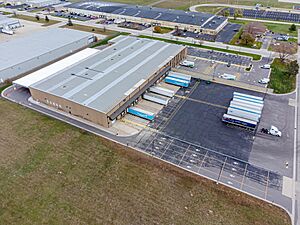
- Amazon Flex, a smartphone app that enables individuals to act as independent contractors, delivering packages to customers from personal vehicles without uniforms. Deliveries include one or two hours Prime Now, same or next day Amazon Fresh groceries, and standard Amazon.com orders, in addition to orders from local stores that contract with Amazon.
- Amazon Logistics, in which Amazon contracts with small businesses (which it calls "Delivery Service Partners") to perform deliveries to customers. Each business has a fleet of approximately 20–40 Amazon-branded vans, and employees of the contractors wear Amazon uniforms. As of December 2020, it operates in the United States, Canada, Italy, Germany, Spain, and the United Kingdom.
- Amazon Prime Air is an experimental drone delivery service that delivers packages via drones to Amazon Prime subscribers in select cities.
Amazon directly employs people to work at its warehouses, bulk distribution centers, staffed "Amazon Hub Locker+" locations, and delivery stations where drivers pick up packages. As of December 2020, it is not hiring delivery drivers as employees.
Rakuten Intelligence estimated that in 2020 in the United States, the proportion of last-mile deliveries was 56% by Amazon's directly contracted services (mostly in urban areas), 30% by the US Postal Service (mostly in rural areas), and 14% by UPS. In April 2021, Amazon reported to investors it had increased its in-house delivery capacity by 50% in the last 12 months (which included the first year of the COVID-19 pandemic in the United States).
Supply chain
Amazon first launched its distribution network in 1997 with two fulfillment centers in Seattle and New Castle, Delaware. Amazon has several types of distribution facilities consisting of cross-dock centers, fulfillment centers, sortation centers, delivery stations, Prime now hubs, and Prime air hubs. There are 75 fulfillment centers and 25 sortation centers with over 125,000 employees. Employees are responsible for five basic tasks: unpacking and inspecting incoming goods; placing goods in storage and recording their location; picking goods from their computer recorded locations to make up an individual shipment; sorting and packing orders; and shipping. A computer that records the location of goods and maps out routes for pickers plays a key role: employees carry hand-held computers which communicate with the central computer and monitor their rate of progress. Some warehouses are partially automated with systems built by Amazon Robotics.
In September 2006, Amazon launched a program called FBA (Fulfillment By Amazon) whereby it could handle storage, packing and distribution of products and services for small sellers.
-
Amazon.es fulfillment center in San Fernando de Henares, Spain
-
Amazon.co.uk fulfillment center in Glenrothes, Scotland, UK
-
Amazon.co.jp fulfillment center in Ichikawa, Japan
-
Amazon fulfillment center in Macon, Georgia, US
Corporate affairs
Board of directors
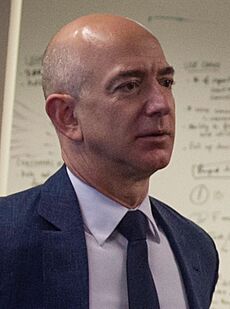
As of June 2022[update], Amazon's board of directors were:
- Jeff Bezos, executive chairman, Amazon.com, Inc.
- Andy Jassy, president and CEO, Amazon.com, Inc.
- Keith B. Alexander, CEO of IronNet Cybersecurity, former NSA director
- Edith W. Cooper, co-founder of Medley and former EVP of Goldman Sachs
- Jamie Gorelick, partner, Wilmer Cutler Pickering Hale and Dorr
- Daniel P. Huttenlocher, dean of the Schwarzman College of Computing, Massachusetts Institute of Technology
- Judy McGrath, former CEO, MTV Networks
- Indra Nooyi, former CEO, PepsiCo
- Jon Rubinstein, former chairman and CEO, Palm, Inc.
- Patty Stonesifer, president and CEO, Martha's Table
- Wendell P. Weeks, chairman, president and CEO, Corning Inc.
Ownership
The 10 largest shareholder of Amazon in early 2024 were:
| Shareholder name | Percentage |
|---|---|
| Jeff Bezos | 9.1% |
| The Vanguard Group | 7.5% |
| BlackRock | 4.6% |
| State Street Corporation | 3.3% |
| Fidelity Investments | 3.1% |
| MacKenzie Scott | 1.9% |
| T. Rowe Price | 1.9% |
| Geode Capital Management | 1.8% |
| JP Morgan Investment Management | 1.5% |
| Eaton Vance | 1.5% |
| Others | 63.8% |
Finances
| Business | share |
|---|---|
| Online Stores | 40.3% |
| Third-party Seller Services | 24.4% |
| Amazon Web Services | 15.8% |
| Advertising | 8.2% |
| Subscription Services | 7.0% |
| Physical Stores | 3.5% |
| Other | 0.9% |
Amazon.com is primarily a retail site with a sales revenue model; Amazon takes a small percentage of the sale price of each item that is sold through its website while also allowing companies to advertise their products by paying to be listed as featured products. As of 2018[update], Amazon.com is ranked eighth on the Fortune 500 rankings of the largest United States corporations by total revenue. In Forbes Global 2000 2023 Amazon ranked 36th.
For the fiscal year 2021, Amazon reported earnings of US$33.36 billion, with an annual revenue of US$469.82 billion, an increase of 21.7% over the previous fiscal cycle. Since 2007 sales increased from 14.835 billion to 469.822 billion, due to continued business expansion.
Amazon's market capitalization went over US$1 trillion again in early February 2020 after the announcement of the fourth quarter 2019 results.
| Year | Revenue in million US$ |
Net income in million US$ |
Total Assets in million US$ |
Employees |
|---|---|---|---|---|
| 1995 | 0.5 | −0.3 | 1.1 | |
| 1996 | 16 | −6 | 8 | |
| 1997 | 148 | −28 | 149 | 614 |
| 1998 | 610 | −124 | 648 | 2,100 |
| 1999 | 1,639 | −720 | 2,466 | 7,600 |
| 2000 | 2,761 | −1,411 | 2,135 | 9,000 |
| 2001 | 3,122 | −567 | 1,638 | 7,800 |
| 2002 | 3,932 | −149 | 1,990 | 7,500 |
| 2003 | 5,263 | 35 | 2,162 | 7,800 |
| 2004 | 6,921 | 588 | 3,248 | 9,000 |
| 2005 | 8,490 | 359 | 3,696 | 12,000 |
| 2006 | 10,711 | 190 | 4,363 | 13,900 |
| 2007 | 14,835 | 476 | 6,485 | 17,000 |
| 2008 | 19,166 | 645 | 8,314 | 20,700 |
| 2009 | 24,509 | 902 | 13,813 | 24,300 |
| 2010 | 34,204 | 1,152 | 18,797 | 33,700 |
| 2011 | 48,077 | 631 | 25,278 | 56,200 |
| 2012 | 61,093 | −39 | 32,555 | 88,400 |
| 2013 | 74,452 | 274 | 40,159 | 117,300 |
| 2014 | 88,988 | −241 | 54,505 | 154,100 |
| 2015 | 107,006 | 596 | 64,747 | 230,800 |
| 2016 | 135,987 | 2,371 | 83,402 | 341,400 |
| 2017 | 177,866 | 3,033 | 131,310 | 566,000 |
| 2018 | 232,887 | 10,073 | 162,648 | 647,500 |
| 2019 | 280,522 | 11,588 | 225,248 | 798,000 |
| 2020 | 386,064 | 21,331 | 321,195 | 1,298,000 |
| 2021 | 469,822 | 33,364 | 420,549 | 1,608,000 |
| 2022 | 513,983 | −2,722 | 462,675 | 1,541,000 |
| 2023 | 574,785 | 30,425 | 527,854 | 1,525,000 |
See also
 In Spanish: Amazon para niños
In Spanish: Amazon para niños


